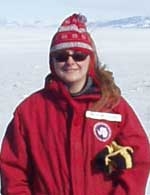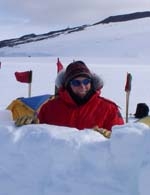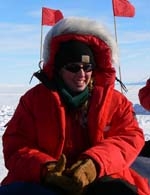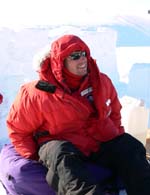Abandoned southern elephant seal colonies as paleoclimate indicators in the Antarctic
Abandoned southern elephant seal colonies as paleoclimate indicators in the Antarctic.
Abandoned Southern Elephant Seal Colonies
as Paleoclimate Indicators in the Antarctic
Brenda Hall, Audrey Bamberg, Alice Doughty, University of Maine.
Seth Newsome, University of California, Santa Cruz
January 1 to February 15, 2006
This is a multidisciplinary project centered on abandoned southern elephant seal colonies located along the Victoria Land coast of the Ross Sea. Southern elephant seals currently do not have breeding or moulting sites within the Ross Sea, which is considerably south of their primary habitat in the Subantarctic. In previous work, we discovered that the seals once occupied large areas of the Victoria Land coast at times between about 500 and 7000 years ago. We believe that the presence or absence of elephant seals in this region is largely due to the extent and duration of sea-ice cover. The coast today is locked in land-fast ice, but must have been ice-free when the seals were present. Therefore, a primary goal of our project is to reconstruct past sea-ice and climate variations using the elephant seal records. Our work will involve excavating and dating the seal remains (primarily moulted skin and hair) in order to reconstruct the geographic extent of the population over time. We also will be comparing the elephant seal data with similar paleoclimate records derived from Adelie penguins, which are more tolerant of sea ice (and, indeed, require pack ice). A combination of the two species will allow us to address qualitatively the degree to which sea ice was reduced or enhanced. This part of the project will be carried out primarily by researchers at the University of Maine (Dr. Brenda Hall – seals) and the Università di Pisa (Dr. Carlo Baroni – penguins). When complete, we hope to produce a record of sea-ice and climate variations in the western Ross Sea region over the past 7000 years. This work will allow us to address questions of global climate change. Our preliminary data indicate two 1500-yr periods in the last 7000 years when elephant seals occupied the coast and thus conditions were warmer than present.
Our work also has two other important goals. The first is to use stable isotopes to assess the seal ecology and gain insight into where they were foraging and what they were eating. We will then compare these data to the chronological information to see if foraging habitat changed over time, perhaps as climate varied. This work is being performed at the University of California, Santa Cruz under the direction of Dr. Paul Koch. The other aspect of our work is to analyze the mitochondrial DNA of the seal remains. This will allow us to address several important questions, such as the rates of genetic mutations over time, the relatedness of the abandoned colonies to existing populations, and the decline of genetic diversity as the Ross Sea population fluctuated and eventually became locally extinct. This work will be carried out at the University of Durham (U.K.) under the direction of Dr. Rus Hoelzel.
 Our work is supported by the Office of Polar Programs of the National Science Foundation and by the Italian Antarctic Program.
Our work is supported by the Office of Polar Programs of the National Science Foundation and by the Italian Antarctic Program.







